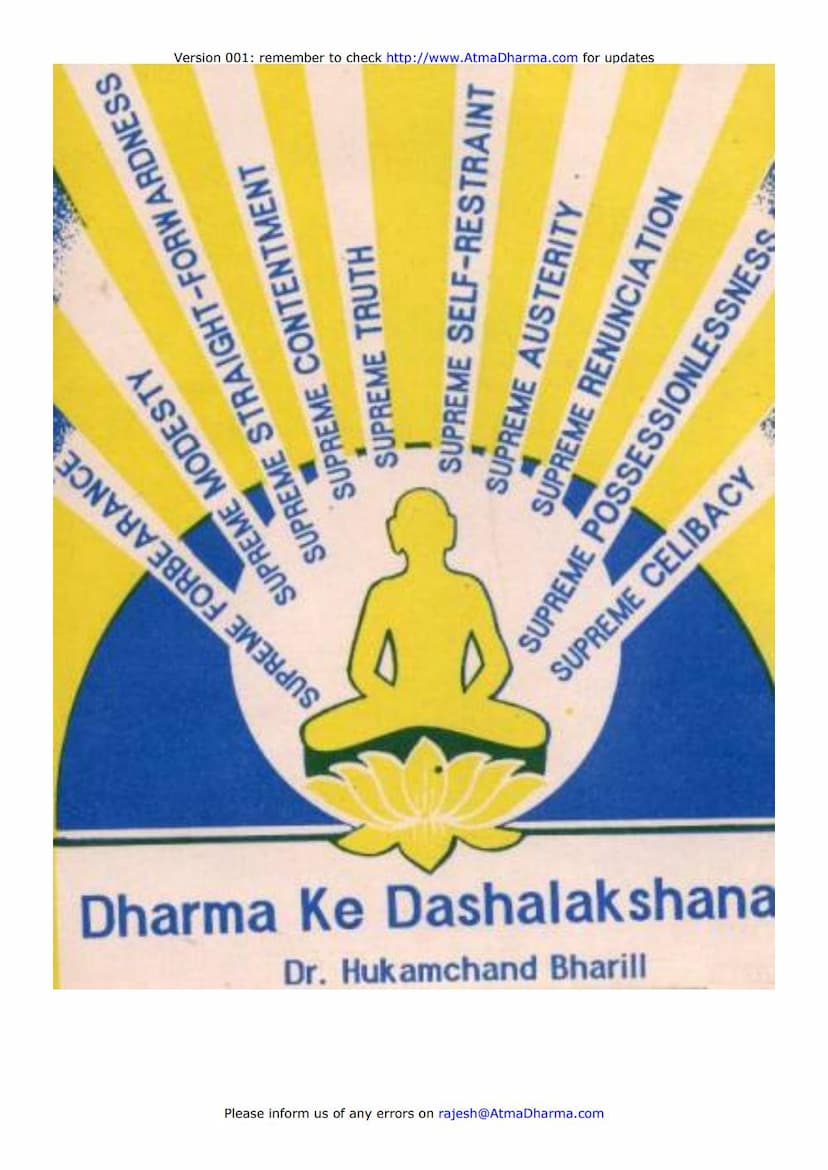Dharma Ke Das Lakshana
Added to library: September 1, 2025

Summary
Here's a comprehensive summary of the provided Jain text, "Dharma Ke Das Lakshana," based on the supplied pages:
The book "Dharma Ke Das Lakshana" (The Ten Characteristics of Religion) by Dr. Hukamchand Bharill, translated by Br. Hemchand Jain 'Hem' and edited by Prof. Jamnalal Jain, is a profound exploration of a significant Jain festival and its underlying principles.
The Core Concept: The Festival of Ten Virtues
The text begins by contrasting Jain festivals like 'Ashtanhika' and 'Dasha Lakshana' with typical worldly festivals. While worldly festivals are often associated with indulgence in food, play, and sensory enjoyment, Jain festivals are characterized by abstinence and continence. They are considered "great festivals" because their greatness lies in self-restraint and spiritual discipline, not amusement. During the 'Dasha Lakshana' festival, individuals observe vows, fast, limit their diet (e.g., avoiding vegetables), dedicate maximum time to scripture study and discourse, engage in religious activities, and make donations according to their capacity, fostering a pervasive religious atmosphere.
The Universality and Eternity of 'Dasha Lakshana'
A key theme is the distinction between eternal (permanent) festivals and periodical (temporary) festivals. Temporary festivals are tied to specific events or personages (like Deepawali, Mahaveera Jayanti, Holi, Raksha Bandhan), and their relevance is limited by time and context. They are seen as fleeting, as future events or more significant figures might overshadow them.
In contrast, 'Dasha Lakshana Mahaparva' is presented as an eternal festival. Its significance is not tied to any particular person or event but to the natural traits and qualities of the soul. These virtues, such as supreme forbearance, emerge as impurities like anger are shed. The festival's universal and eternal nature stems from the fact that emotions like anger are universally recognized as harmful, while forbearance and similar virtues are universally beneficial. This makes them relevant across all times and to all living beings.
The text argues that this universality is also the reason for its eternity: anger has always been considered something to be given up, and forbearance something to be embraced, and this perception will continue indefinitely. The distress caused by anger and the peace derived from forbearance are timeless experiences.
The "Beginning" of the Eternal Festival
A potential doubt is addressed: if the festival is eternal, why do scriptures mention its beginning? The text explains this through the Jain concept of cosmic cycles ('Avasarpani' and 'Utsarpani'). At the end of the 'Avasarpani' period (a time of decline) and the beginning of the 'Utsarpani' period (a time of development), a restart of religious practice occurs. This is depicted through a narrative where specific rains help usher in a period of civilized instinct and the re-emergence of religious observance, including the adoration of the ten virtues.
However, this "beginning" is not the beginning of the festival itself but rather its re-initiation within each cycle of religious development. The story itself is eternal and repeats. The underlying virtues of the soul, though sometimes obscured by emotions, have always existed. Since souls have always been unhappy due to negative emotions and have always sought happiness, the need for virtues like supreme forbearance, the root of happiness, is also timeless.
The Ten Virtues Defined
The ten virtues, also referred to as the "ten religions" or "ten commandments," are explicitly listed:
- Supreme Forbearance ('Uttama Kshama')
- Supreme Modesty ('Uttama Mardava')
- Supreme Straight-forwardness ('Uttama Arjava')
- Supreme Purity ('Uttama Shaucha')
- Supreme Truth ('Uttama Satya')
- Supreme Self-restraint ('Uttama Samyama')
- Supreme Austerity ('Uttama Tapa')
- Supreme Renunciation ('Uttama Tyaga')
- Supreme Non-attachment ('Uttama Akinchanya')
- Supreme Celibacy ('Uttama Brahmacharya')
The Nature of These Virtues
These are presented as the characteristics of religion that naturally manifest in a soul that has achieved right belief ('Samyagdarshan') and right knowledge ('Samyagjnan'). The prefix "Supreme" signifies the essential presence of these foundational spiritual elements. Without right belief and knowledge, the practice of these virtues is not considered true religion, even if outward actions suggest restraint.
The text quotes Pundit Todarmalji, emphasizing that true religious conduct arises not from the fear of punishment or the desire for heavenly reward but from the understanding that nothing is inherently good or bad, leading to the natural cessation of emotions like anger. This cessation, coupled with right belief and knowledge, constitutes the religion of supreme forbearance.
Observance for All: Saints and Householders
While these virtues are described from the perspective of monks ('Muni Dharma'), they are not exclusive to them. Householders ('Shravakas') are also expected to observe them according to their spiritual stage. The intensity of passionlessness and the manifestation of these virtues differ based on one's spiritual progress. For instance, monks exhibit the absence of the most intense passions, while householders at advanced stages exhibit the absence of lesser, yet still intense, passions.
The text clarifies that true religion is the natural disposition arising from the absence of perverse belief and intense passions, not merely a reduction in their intensity. 'Leshyas' (thought colors) are a consequence of reduced passion intensity, not religion itself.
The Festival's Timing and Significance
The 'Dasha Lakshana Mahaparva' occurs three times a year (in Bhadrapad, Magh, and Chaitra months), but it is most prominently celebrated in the month of Bhadrapad (from the 5th to the 14th of the Shukla Paksha). This timing is attributed to the rainy season, during which monks typically stay in one place, and household members travel less, allowing for greater participation and communal religious focus.
Ultimately, the festival is about self-adoration and the evolution of the soul's inherent virtuous qualities. It's an auspicious occasion aimed at attaining eternal happiness and self-bliss by understanding and embodying these ten fundamental characteristics of the soul.